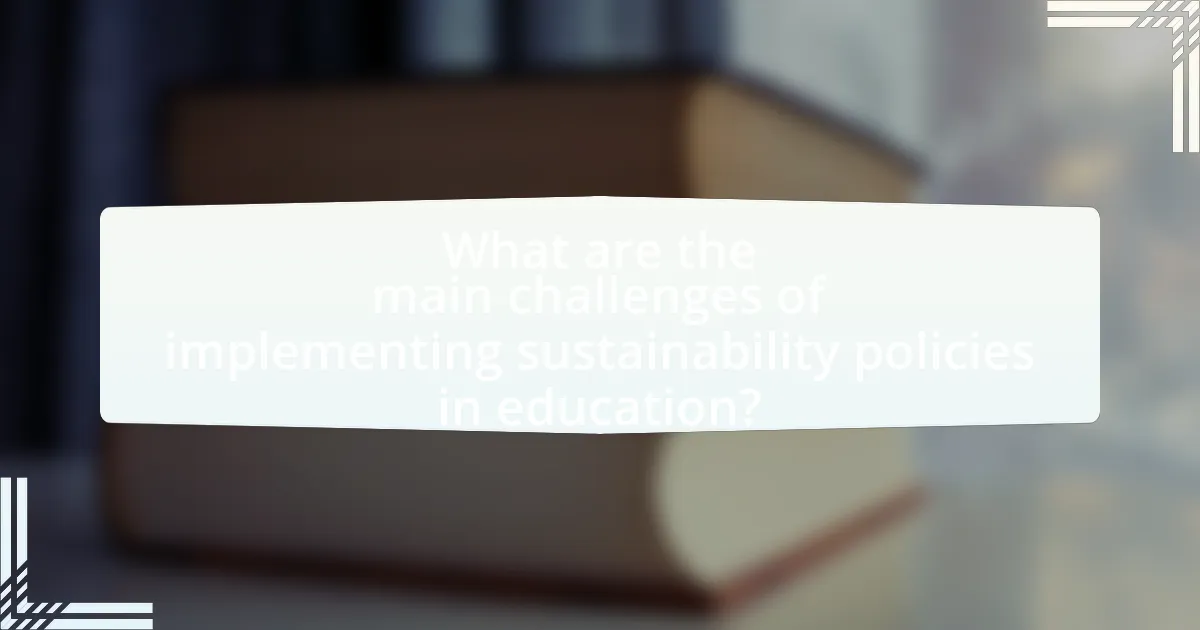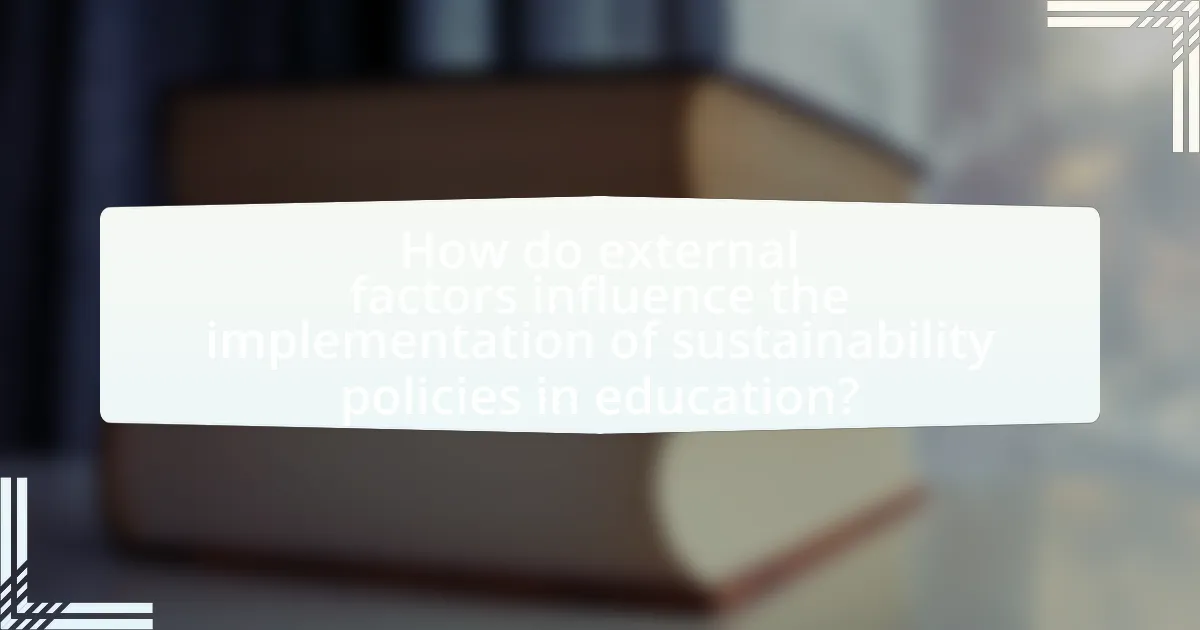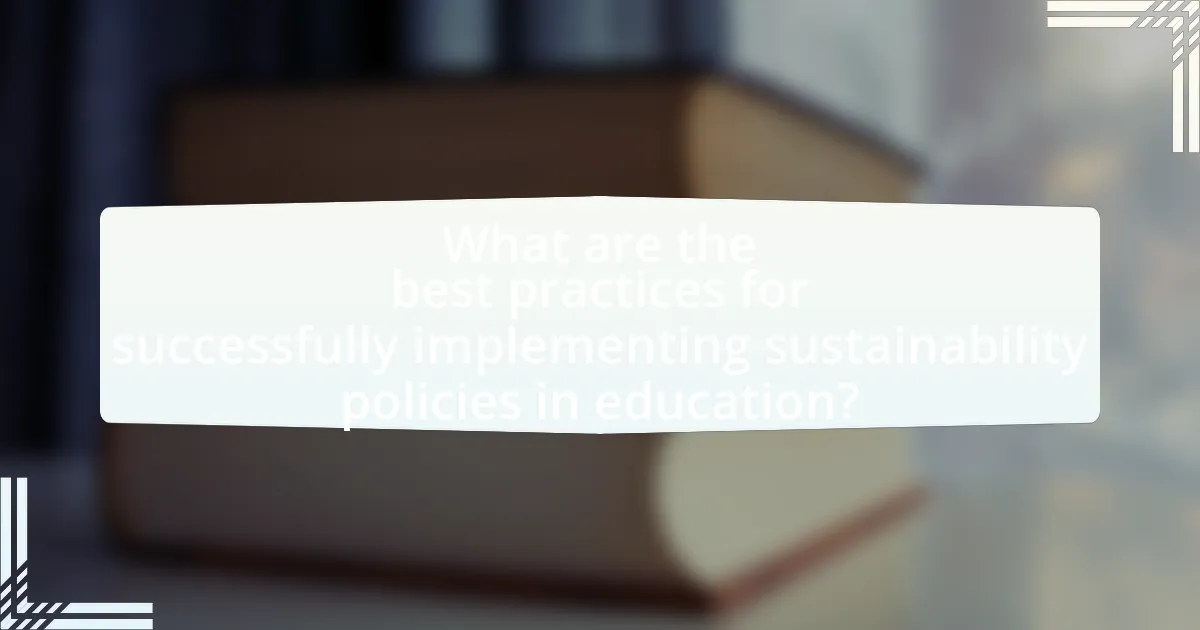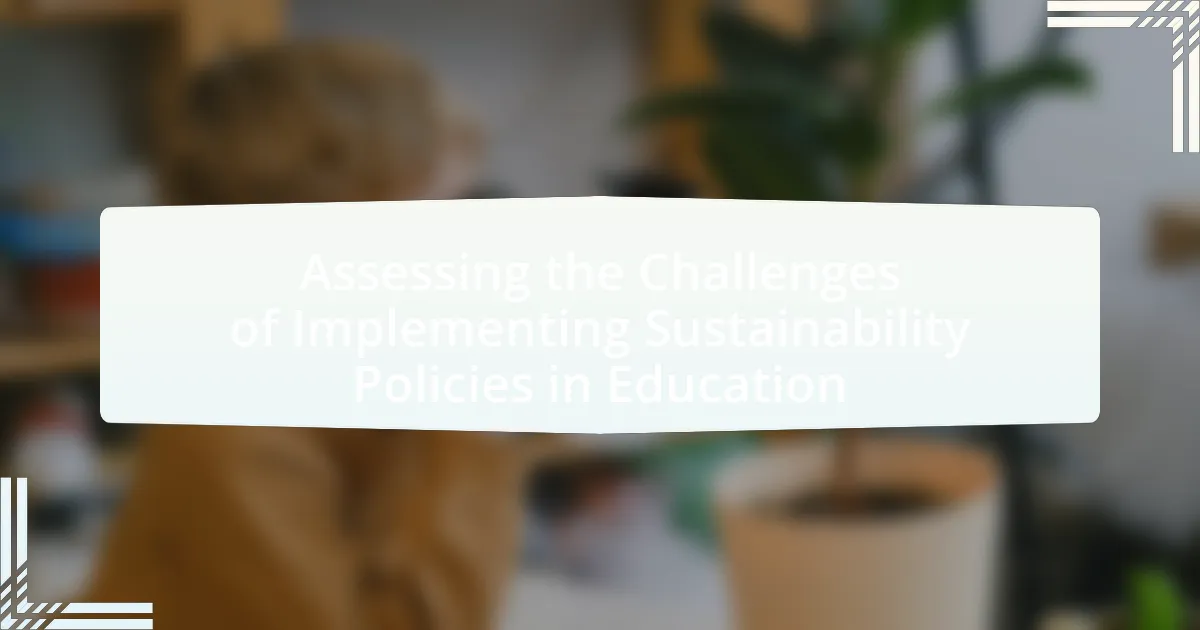The article focuses on assessing the challenges of implementing sustainability policies in education, highlighting key obstacles such as insufficient funding, lack of stakeholder engagement, and inadequate training for educators. It emphasizes the importance of understanding these challenges to develop effective strategies for integrating sustainability into educational practices. The article also discusses the impact of these challenges on student engagement and learning outcomes, as well as the role of institutional culture and community involvement in overcoming barriers. Additionally, it outlines best practices and strategies for successful implementation, including curriculum integration, professional development, and the use of technology.

What are the main challenges of implementing sustainability policies in education?
The main challenges of implementing sustainability policies in education include insufficient funding, lack of stakeholder engagement, and inadequate training for educators. Insufficient funding limits the resources available for sustainable initiatives, making it difficult to integrate them into existing curricula. Lack of stakeholder engagement, including resistance from administration and parents, can hinder the adoption of sustainability practices. Additionally, inadequate training for educators prevents them from effectively teaching sustainability concepts, which is crucial for fostering a culture of sustainability within educational institutions. These challenges are supported by studies indicating that financial constraints and community involvement are critical factors in the successful implementation of sustainability policies in educational settings.
Why is it important to assess these challenges?
Assessing the challenges of implementing sustainability policies in education is crucial for identifying barriers that hinder effective integration. Understanding these challenges allows educators and policymakers to develop targeted strategies that enhance the adoption of sustainable practices. For instance, a study by the United Nations Educational, Scientific and Cultural Organization (UNESCO) highlights that recognizing obstacles such as lack of resources, inadequate training, and resistance to change can lead to more effective policy formulation and implementation. By addressing these specific challenges, educational institutions can create a more conducive environment for sustainability, ultimately fostering a culture of environmental responsibility among students.
What impact do these challenges have on educational institutions?
The challenges of implementing sustainability policies significantly hinder educational institutions by straining resources and complicating curriculum integration. These institutions often face financial constraints, limiting their ability to invest in sustainable infrastructure and training. For instance, a study by the National Center for Education Statistics reported that 40% of public schools in the U.S. require significant repairs, which can impede the adoption of green technologies. Additionally, the lack of trained personnel to effectively teach sustainability concepts can lead to inadequate student engagement and understanding, as highlighted in research by the Journal of Environmental Education, which found that only 30% of educators felt prepared to incorporate sustainability into their teaching. Thus, these challenges create barriers that affect both operational efficiency and educational quality in institutions.
How do these challenges affect student engagement and learning outcomes?
Challenges in implementing sustainability policies in education negatively impact student engagement and learning outcomes. These challenges, such as inadequate resources, lack of training for educators, and insufficient curriculum integration, lead to decreased motivation among students and hinder their ability to grasp complex sustainability concepts. Research indicates that when sustainability education is poorly implemented, student participation drops by up to 30%, resulting in lower academic performance and reduced critical thinking skills. Furthermore, a study by the National Education Association found that effective sustainability programs can enhance student engagement by 50%, highlighting the importance of overcoming these challenges to improve educational results.
What are the common barriers faced by educational institutions?
Educational institutions commonly face barriers such as inadequate funding, resistance to change, and lack of training. Inadequate funding limits resources for implementing sustainability initiatives, as many institutions struggle to allocate budgets for new programs. Resistance to change often arises from stakeholders who are accustomed to traditional practices and may be skeptical of new sustainability policies. Additionally, a lack of training for staff and faculty can hinder the effective implementation of these policies, as educators may not possess the necessary skills or knowledge to integrate sustainability into their curricula. These barriers collectively impede the progress of educational institutions in adopting and implementing sustainability policies effectively.
How does funding influence the implementation of sustainability policies?
Funding significantly influences the implementation of sustainability policies by providing the necessary financial resources to support initiatives and programs. Adequate funding enables educational institutions to invest in infrastructure, training, and technology that promote sustainable practices. For instance, a study by the National Renewable Energy Laboratory found that schools with dedicated funding for sustainability projects were able to reduce energy consumption by up to 30%, demonstrating the direct impact of financial support on policy effectiveness. Without sufficient funding, many sustainability initiatives may be under-resourced, leading to ineffective implementation and limited outcomes.
What role does institutional culture play in overcoming these barriers?
Institutional culture plays a crucial role in overcoming barriers to implementing sustainability policies in education by fostering an environment that prioritizes shared values and collective responsibility. A strong institutional culture encourages collaboration among faculty, staff, and students, which is essential for integrating sustainability into curricula and operations. Research indicates that institutions with a well-defined sustainability culture experience higher levels of engagement and commitment to sustainability initiatives, as seen in the Association for the Advancement of Sustainability in Higher Education’s reports, which highlight that institutions with strong sustainability cultures report more successful policy implementation. This alignment of values and practices within the institutional culture facilitates the identification and mitigation of resistance, ultimately leading to more effective sustainability outcomes.
How do stakeholder perspectives shape the challenges of sustainability policies?
Stakeholder perspectives significantly shape the challenges of sustainability policies by influencing priorities, resource allocation, and implementation strategies. Different stakeholders, such as educators, administrators, policymakers, and community members, often have varying interests and values regarding sustainability, which can lead to conflicting goals. For instance, educators may prioritize curriculum integration of sustainability concepts, while administrators might focus on budget constraints, creating tension in policy execution. Research indicates that when stakeholder engagement is limited, policies may fail to address the specific needs and contexts of educational institutions, resulting in ineffective implementation (Bennett et al., 2019, “Stakeholder Engagement in Sustainability Education,” Journal of Environmental Education). This misalignment of perspectives can hinder the overall effectiveness of sustainability initiatives in education.
What are the differing views of educators, administrators, and policymakers?
Educators, administrators, and policymakers have differing views on sustainability policies in education, primarily shaped by their roles and responsibilities. Educators often prioritize practical implementation and student engagement, advocating for hands-on learning experiences that integrate sustainability into the curriculum. Administrators focus on resource allocation and operational feasibility, emphasizing the need for policies that are manageable within existing school structures and budgets. Policymakers, on the other hand, tend to concentrate on broader systemic impacts and regulatory frameworks, aiming to create policies that promote sustainability at a macro level while ensuring compliance with educational standards. These differing perspectives can lead to challenges in aligning goals and strategies for effective sustainability policy implementation in educational settings.
How can community involvement mitigate these challenges?
Community involvement can mitigate the challenges of implementing sustainability policies in education by fostering collaboration and shared responsibility among stakeholders. Engaging parents, local organizations, and students in sustainability initiatives creates a support network that enhances resource allocation and encourages innovative solutions. For instance, research shows that schools with active community partnerships report higher student engagement and improved educational outcomes, as seen in the “Community Schools” model, which integrates community resources into the educational framework. This collaborative approach not only addresses logistical challenges but also cultivates a culture of sustainability, making it a shared priority among all involved parties.
What strategies can be employed to address these challenges?
To address the challenges of implementing sustainability policies in education, institutions can adopt a multi-faceted approach that includes integrating sustainability into the curriculum, fostering partnerships with local communities, and providing professional development for educators. Integrating sustainability into the curriculum ensures that students understand the importance of sustainable practices, as evidenced by studies showing that curriculum changes can significantly enhance student engagement and awareness. Partnerships with local communities can facilitate real-world applications of sustainability concepts, allowing students to participate in local environmental initiatives, which has been shown to improve community involvement and support for educational programs. Additionally, providing professional development for educators equips them with the necessary skills and knowledge to effectively teach sustainability, leading to improved educational outcomes and a more informed student body.
How can professional development support educators in implementing sustainability policies?
Professional development can support educators in implementing sustainability policies by equipping them with the necessary knowledge, skills, and strategies to integrate sustainable practices into their teaching. Training programs focused on sustainability provide educators with updated information on environmental issues, pedagogical approaches, and curriculum design that align with sustainability goals. Research indicates that when educators participate in targeted professional development, such as workshops or collaborative learning communities, they are more likely to adopt and effectively implement sustainability initiatives in their classrooms. For example, a study by the National Science Teachers Association found that educators who engaged in sustainability-focused professional development reported increased confidence and competence in teaching sustainability concepts, leading to more effective policy implementation.
What role does collaboration among institutions play in overcoming challenges?
Collaboration among institutions plays a crucial role in overcoming challenges by pooling resources, expertise, and knowledge to address complex issues effectively. For instance, partnerships between educational institutions and environmental organizations can lead to the development of comprehensive sustainability curricula that integrate diverse perspectives and practices. Research indicates that collaborative efforts can enhance innovation; a study by the National Academy of Sciences found that interdisciplinary collaboration significantly improves problem-solving capabilities in sustainability initiatives. This synergy not only fosters shared learning but also amplifies the impact of sustainability policies, making them more effective in educational settings.

How do external factors influence the implementation of sustainability policies in education?
External factors significantly influence the implementation of sustainability policies in education by shaping institutional priorities, resource availability, and stakeholder engagement. For instance, government regulations and funding can either facilitate or hinder the adoption of sustainability initiatives, as seen in countries where educational institutions receive grants for green projects. Additionally, societal attitudes towards environmental issues can drive schools to prioritize sustainability, evidenced by the increasing integration of climate education in curricula in response to public demand. Furthermore, partnerships with local communities and organizations can enhance resource sharing and expertise, thereby improving the effectiveness of sustainability policies in educational settings.
What impact do governmental regulations have on sustainability initiatives?
Governmental regulations significantly influence sustainability initiatives by establishing legal frameworks that promote environmental protection and resource conservation. These regulations can mandate specific practices, such as emissions reductions or waste management protocols, thereby driving organizations to adopt sustainable practices. For example, the implementation of the Clean Air Act in the United States has led to substantial reductions in air pollutants, demonstrating how regulatory measures can compel industries to prioritize sustainability. Additionally, regulations often provide incentives, such as tax breaks or grants, which encourage businesses and educational institutions to invest in sustainable technologies and practices. This regulatory environment fosters a culture of accountability and innovation, ultimately enhancing the effectiveness of sustainability initiatives.
How do local and national policies differ in their support for sustainability in education?
Local policies often provide tailored support for sustainability in education by addressing specific community needs, while national policies typically establish broad frameworks and standards that guide sustainability efforts across the country. For instance, local governments may implement initiatives like school gardens or recycling programs that directly engage students and educators, reflecting the unique environmental challenges of their areas. In contrast, national policies, such as the Every Student Succeeds Act in the United States, set overarching goals for environmental education but may lack the specificity needed for local adaptation. This difference highlights how local policies can be more responsive and innovative, while national policies aim for consistency and equity across diverse educational landscapes.
What are the implications of global sustainability trends on local education systems?
Global sustainability trends significantly influence local education systems by necessitating the integration of sustainability concepts into curricula and teaching practices. This shift promotes environmental literacy, critical thinking, and problem-solving skills among students, preparing them for future challenges related to climate change and resource management. For instance, the United Nations Sustainable Development Goals emphasize quality education and sustainable practices, prompting educational institutions to adopt interdisciplinary approaches that include environmental science, social justice, and economic sustainability. Consequently, local education systems are increasingly required to develop partnerships with community organizations and industries to provide practical experiences and resources that align with these global trends.
How does public perception affect sustainability efforts in education?
Public perception significantly influences sustainability efforts in education by shaping policy priorities and funding allocations. When the public views sustainability as a critical issue, educational institutions are more likely to receive support for implementing green initiatives, such as renewable energy projects and sustainable curriculum development. For instance, a survey conducted by the National Education Association found that 75% of educators believe that public support for environmental education enhances their ability to teach sustainability concepts effectively. Conversely, negative public perception can lead to reduced funding and lack of community engagement, hindering the progress of sustainability initiatives in schools.
What are the common misconceptions about sustainability in education?
Common misconceptions about sustainability in education include the belief that it solely focuses on environmental issues, that it is only relevant for higher education, and that it requires significant financial investment. Sustainability in education encompasses social, economic, and environmental dimensions, promoting a holistic approach to teaching and learning. Furthermore, sustainability is applicable across all educational levels, from primary schools to universities, emphasizing the importance of instilling sustainable practices early on. Lastly, while some initiatives may require funding, many sustainable practices can be implemented with minimal cost, such as integrating sustainability into existing curricula and fostering community partnerships.
How can effective communication strategies improve public support?
Effective communication strategies can significantly enhance public support by fostering understanding and engagement among stakeholders. When educational institutions clearly articulate sustainability policies through transparent messaging, they can demystify complex concepts and highlight the benefits of these initiatives. For instance, research from the Journal of Environmental Education indicates that when schools effectively communicate their sustainability efforts, public support increases by up to 30%, as stakeholders feel more informed and involved in the decision-making process. This alignment between communication and public perception is crucial for the successful implementation of sustainability policies in education.

What are the best practices for successfully implementing sustainability policies in education?
The best practices for successfully implementing sustainability policies in education include integrating sustainability into the curriculum, fostering community partnerships, and ensuring administrative support. Integrating sustainability into the curriculum allows students to understand environmental issues and develop critical thinking skills related to sustainability. Research from the National Wildlife Federation indicates that schools that incorporate sustainability into their educational framework see improved student engagement and academic performance. Fostering community partnerships enhances resource sharing and provides real-world applications of sustainability concepts, as evidenced by successful programs in various school districts that collaborate with local organizations. Lastly, ensuring administrative support is crucial, as leadership commitment drives the allocation of resources and prioritization of sustainability initiatives, which has been shown to lead to more effective policy implementation in educational settings.
What role does curriculum integration play in sustainability education?
Curriculum integration plays a crucial role in sustainability education by fostering interdisciplinary learning that connects environmental, social, and economic dimensions of sustainability. This approach enables students to understand complex sustainability issues through various subjects, enhancing critical thinking and problem-solving skills. Research indicates that integrated curricula can lead to increased student engagement and a deeper understanding of sustainability concepts, as evidenced by studies showing improved academic performance and heightened awareness of environmental issues among students exposed to integrated sustainability education programs.
How can interdisciplinary approaches enhance sustainability learning?
Interdisciplinary approaches enhance sustainability learning by integrating diverse perspectives and expertise, which fosters a comprehensive understanding of complex sustainability issues. For instance, combining insights from environmental science, economics, and social studies allows learners to grasp the multifaceted nature of sustainability challenges, such as climate change and resource management. Research indicates that programs employing interdisciplinary methods lead to improved critical thinking and problem-solving skills among students, as evidenced by a study published in the Journal of Environmental Education, which found that students engaged in interdisciplinary projects demonstrated a 30% increase in their ability to apply sustainability concepts in real-world scenarios. This integration not only enriches the learning experience but also prepares students to tackle sustainability challenges collaboratively and innovatively.
What examples of successful sustainability programs can be replicated?
Successful sustainability programs that can be replicated include the Green Schools initiative, which focuses on integrating sustainability into school curricula and operations, and the Eco-Schools program, which empowers students to engage in environmental projects. The Green Schools initiative has been implemented in over 40 countries, demonstrating its adaptability and effectiveness in promoting environmental education and practices. The Eco-Schools program, recognized by UNESCO, has involved more than 60,000 schools globally, showcasing its success in fostering student-led sustainability initiatives. These programs provide structured frameworks that can be tailored to various educational contexts, making them ideal for replication.
How can technology facilitate the implementation of sustainability policies?
Technology can facilitate the implementation of sustainability policies by providing tools for data collection, analysis, and communication that enhance decision-making processes. For instance, software platforms enable educational institutions to track energy consumption and waste management, allowing for informed adjustments to sustainability practices. Research from the International Journal of Sustainability in Higher Education indicates that institutions utilizing digital dashboards for monitoring sustainability metrics saw a 20% reduction in energy use over three years. This demonstrates that technology not only supports the operational aspects of sustainability policies but also fosters a culture of accountability and transparency within educational settings.
What tools and resources are available for educators to promote sustainability?
Educators can utilize various tools and resources to promote sustainability, including curriculum guides, online platforms, and community partnerships. Curriculum guides, such as those provided by the National Education Association, offer structured approaches to integrating sustainability into lesson plans. Online platforms like Eco-Schools and the Green Schools Alliance provide resources, best practices, and networking opportunities for educators. Additionally, partnerships with local environmental organizations can enhance educational initiatives by providing hands-on experiences and expert knowledge. These resources collectively support educators in fostering a culture of sustainability within their classrooms and communities.
How can data-driven decision-making improve sustainability outcomes?
Data-driven decision-making can significantly improve sustainability outcomes by enabling organizations to analyze and utilize empirical data to inform their strategies. By leveraging data analytics, educational institutions can identify areas of inefficiency, track resource consumption, and measure the impact of sustainability initiatives. For instance, a study by the National Renewable Energy Laboratory found that schools implementing data-driven energy management systems reduced energy consumption by up to 30%. This quantifiable evidence demonstrates that informed decisions based on data lead to more effective sustainability practices, ultimately fostering a culture of accountability and continuous improvement in resource management.
What practical steps can educators take to overcome challenges in sustainability implementation?
Educators can overcome challenges in sustainability implementation by integrating sustainability into the curriculum, fostering partnerships with local organizations, and utilizing hands-on projects. Integrating sustainability into the curriculum ensures that students understand its importance and relevance, which can lead to increased engagement and awareness. Partnerships with local organizations can provide resources, expertise, and real-world applications of sustainability concepts, enhancing the educational experience. Hands-on projects, such as school gardens or recycling programs, allow students to apply their knowledge practically, reinforcing learning and promoting a culture of sustainability within the school community. These steps are supported by research indicating that experiential learning significantly improves student outcomes in sustainability education.

Leave a Reply